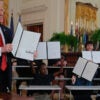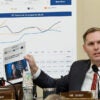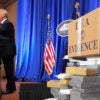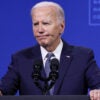When it comes to cap and trade, Secretary of Energy Steven Chu says it’s an economic stimulus. President Obama says it’s a jobs bill. Is it either?
Reporters asked Chu if he though the green movement would generate the townhall pushback the health care debate and he responded, “I don’t think so…maybe I’m optimistic, but there’s very little debate” that a new green energy economy will bring economic prosperity.
The Daily Signal depends on the support of readers like you. Donate now
George Mason economist Russ Roberts offers his own facetious response to Chu:
“That’s right. It’s a free lunch! There’s no trade-off between cleaner air and economic growth.”
Unfortunately for Americans, as taxpayers and energy consumers, the trade-off is rather large:
Cumulative gross domestic product (GDP) losses are $9.4 trillion between 2012 and 2035;
A typical family of four will pay, on average, an additional $829 each year for energy-based utility costs; and
Gasoline prices will rise by 58 percent ($1.38 more per gallon) and average household electric rates will increase by 90 percent by 2035.
Net job losses approach 1.9 million in 2012 and could approach 2.5 million by 2035. Manufacturing loses 1.4 million jobs in 2035;
But President Obama said the opposite was true in an endorsement of the Waxman-Markey cap and trade bill in June:
“The energy bill that passed the House will finally create a set of incentives that will spark a clean energy transformation in our economy. It will spur the development of low carbon sources of energy – everything from wind, solar, and geothermal power to safer nuclear energy and cleaner coal. It will spur new energy savings, like the efficient windows and other materials that reduce heating costs in the winter and cooling costs in the summer. And most importantly, it will make possible the creation of millions of new jobs. Make no mistake: this is a jobs bill.”
Those “incentives” are subsidies and tax credits complements of the taxpayer. And the jobs President Obama speaks of are in fact real. He gave a few examples in his speech: “In California, 3000 people will be employed to build a new solar plant that will create 1000 permanent jobs. In Michigan, investment in wind turbines and wind technology is expected to create over 2,600 jobs. In Florida, three new solar projects are expected to employ 1400 people.”
There’s that free lunch concept again. The subsidies and government handouts for renewable projects means diverts those workers away from more productive use. Moreover, a cap and trade policy will destroy more jobs than it creates. Because cap and trade is a tax on energy, the cost of producing goods for businesses increases, and consumer demand falls for two reasons; price hikes on goods reduce demand and people have less disposable income due to higher energy prices.
Higher energy prices force businesses to make production cuts and reduce labor. Furthermore, as we see in the current recession, reduced consumer spending only exacerbates this. The overall result is increased unemployment and slow economic growth.
And we’re not the only ones projecting such losses. In fact, at a recent Heritage event on the costs of cap and trade, not one of the 6 speakers representing groups who modeled the bill discussed economic benefits from cap and trade – it was all about the magnitude of the losses.































